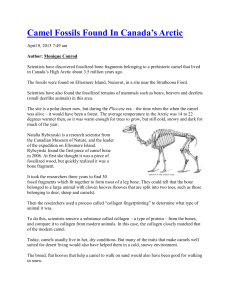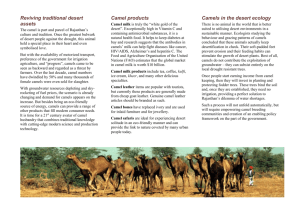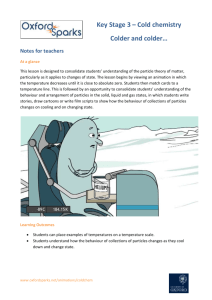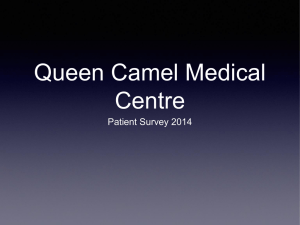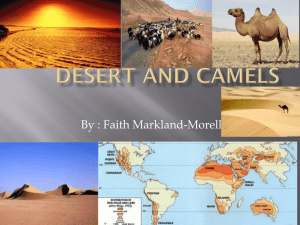The Camel in Rajasthan:
advertisement
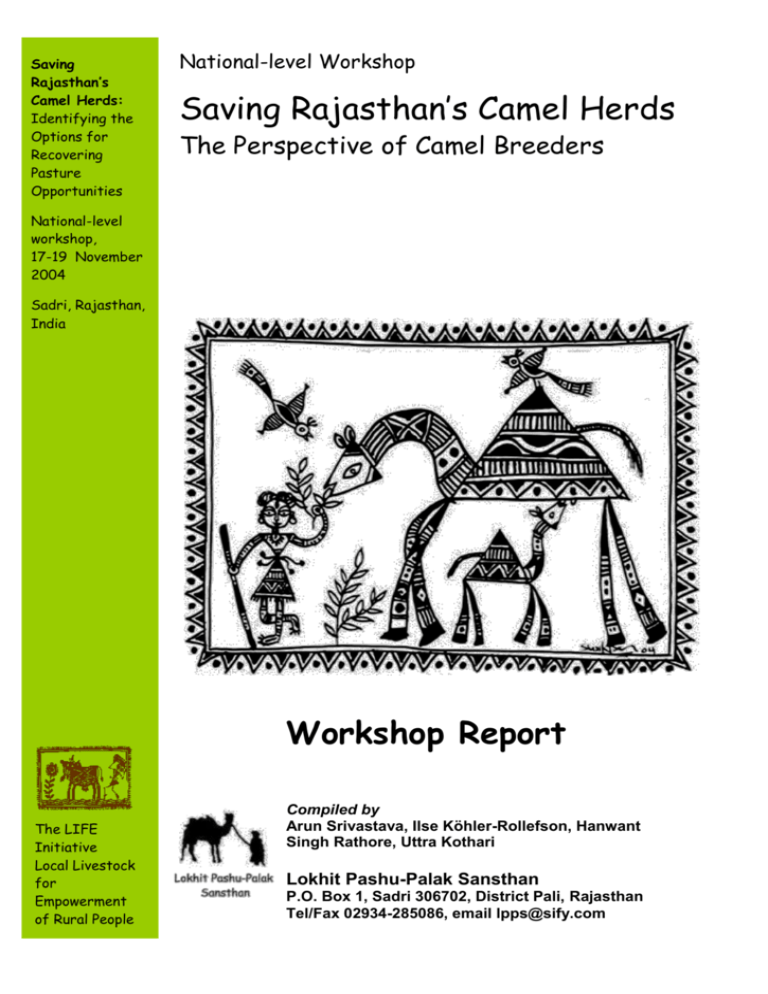
Saving Rajasthan’s Camel Herds: Identifying the Options for Recovering Pasture Opportunities National-level Workshop Saving Rajasthan’s Camel Herds The Perspective of Camel Breeders National-level workshop, 17-19 November 2004 Sadri, Rajasthan, India Workshop Report The LIFE Initiative Local Livestock for Empowerment of Rural People www.lifeinitiativ e.net Compiled by Arun Srivastava, Ilse Köhler-Rollefson, Hanwant Singh Rathore, Uttra Kothari Lokhit Pashu-Palak Sansthan P.O. Box 1, Sadri 306702, District Pali, Rajasthan Tel/Fax 02934-285086, email lpps@sify.com Table of contents Table of contents ........................................................................................... 2 Executive summary ....................................................................................... 3 Introduction .................................................................................................... 4 Background .................................................................................................... 6 Decline in camel population ...........................................................................................6 Socio-economic context of camel breeding and keeping ..............................................6 Reasons for the decline of the camel population ..........................................................7 Institutional context ........................................................................................................8 Workshop objectives ..................................................................................... 9 Process ......................................................................................................... 10 Workshop results......................................................................................... 12 1.Loss of grazing opportunities ................................................................................... 12 2. Access to prophylactic health care and medicines................................................. 14 3. Marketing of camel products .................................................................................. 15 Acknowledgments ....................................................................................... 17 Appendix I: Programme .............................................................................. 18 Appendix-II: Results of group work ........................................................... 19 Problems in Arid Zone (Group 1) ................................................................................ 19 Problems in Intermediate Zone (Group 2) .................................................................. 19 Problems in Aravalli Zone (Group 3) .......................................................................... 20 Appendix-III: Recommendations ................................................................ 22 Appendix IV. Addresses of participants .................................................... 24 Saving Rajasthan’s Camel Herds: Workshop report 2 Executive summary The one-humped camel is a domestic animal that has been developed exclusively by traditional societies and is a product of indigenous knowledge about animal breeding and husbandry. Once symbolic of Rajasthan’s age-old traditions and culture, the camel is now rapidly losing ground and has been experiencing a steep population decline in recent years. This development can be attributed mainly to policies giving preference to irrigated agriculture instead of water-conserving land-use practices attuned to the local ecology. It is a trend that has grave implications for the sustainable use of Rajasthan’s arid lands and its resilience to drought, as well as several hundred thousand families below the poverty line. The people most closely associated with the camel in Rajasthan are the Raika, who earlier took care of the camel breeding-herds of the Maharajas. Originally the Raika acted as guardians of the camels and never sold female camels outside the community, as well as abhorring the idea of selling camels for meat. But due to ever increasing pressure, these social mechanisms and cultural beliefs are now breaking down. In order to better understand the problem and to identify remedial actions, a nationallevel workshop was organised from 17 to 19 November 2004 by Lokhit Pashu-Palak Sansthan in Sadri, Pali district. It aimed to bring together all concerned parties and stakeholders. Fifty camel breeders and users attended the workshop, representing various communities, casts, and religions, and coming from almost all parts of Rajasthan. At the three-day meeting, it became obvious why camel breeders, such as the Raika with their proud history, are abandoning their hereditary profession. Disappearance of pastures is the main factor rendering camel breeding difficult if not impossible. Camel breeders are not involved in any decision-making. There is no national policy on camels. The participants unanimously recommended the following actions and changes: 1. Restoration of traditional grazing areas, commons and identification, restoration and management of new grazing areas with peoples’ participation 2. Inclusion of camel milk in the Rajasthan Dairy Act 3. Availability of camel health care and simple and effective vaccination procedures 4. Total ban on fertile and healthy female camel slaughter 5. The activities of the National Research Centre on Camels should be extended to include an effective system for the ‘transfer of know how’ directly to the camel breeders. Saving Rajasthan’s Camel Herds: Workshop report 3 Introduction Lokhit Pashu-Palak Sansthan (LPPS) is an NGO that started working with camel breeders in Pali district in 1994. In fact the organisation was specifically set up to address some of the complaints by Raika camel herd owners about lack of veterinary care and problems of grazing in the Aravalli Range that had come to light during an earlier research project. For several years, LPPS worked locally, conducting first action research to better understand the problem, then setting up various support mechanisms such as prophylaxis against the main disease problems and initiating camel milk marketing to generate additional income. The project seemed to be a success, so the main focus of LPPS shifted to work with sheep-breeders from the same community whose numbers were much bigger and who also reported various problems. At the same time, close ties with the camel breeders from Godwar and Jojawar were maintained; they regularly visited our office to obtain genuine veterinary medicines, as well as advice and support. When the camel breeders from Jojawar were banned from grazing in the Kumbalgarh Sanctuary, LPPS initiated a public interest litigation suit to reinstitute their rights, which was successful. Since 2001, a new trend was observed at the Pushkar Fair that was cause for deep concern: increasing numbers of female camels were being sold for slaughter. This was a stunning development, since the Raika, as well as all other camel-breeding communities in Rajasthan, traditionally abhor the idea of killing camels or using their meat. One of the community leaders, Bagdi Ramji Raika, requested LPPS help in stopping the sale of camels for slaughter from Pushkar; numerous letters were written to concerned authorities, but solicited no response. The only reply that we received came almost a year later and doubted the very fact that camels went for slaughter. However in early 2003, a helpful NGO in Bangladesh sent us a compilation of newspaper clippings about camels from Rajasthan being smuggled across the border with Bangladesh and being sold for meat in Dhaka and other cities. In November 2003, traders looking for meat camels turned up in large numbers at the Pushkar Fair and reportedly purchased several thousand female camels for this purpose. LPPS resolved to make 2004 the “Year of the Camel”. In early 2004, a re-survey of the camel-holdings in Bali and Desuri tehsils of Pali district revealed an almost 50% decline since 1995! The surveyed families provided three reasons why their camel holdings had declined or they had given up camel breeding altogether: disappearance of pastures, prevalence of disease, and lack of income. LPPS feels that this decline of the camel population and abandonment of camel breeding is a matter with wide-ranging consequences for Rajasthan. It will make Rajasthan more vulnerable to droughts, render it more dependent on non-renewable energy sources, and consequently will have severe negative impacts on the livelihoods of many poor families. In order to raise the issue, LPPS decided to organize an international camel conference that would draw outside expertise and also generate a media response. Because such a conference would be held in English, there was the danger that the camel breeders themselves would not be heard at such a meeting. We were also acutely aware that the survey had been conducted only in a small area which was not even part of Rajasthan’s prime camel breeding zone, and that the picture for Rajasthan as a whole needed to be understood. For this reason we concluded that it was necessary to hold a separate workshop focusing exclusively on the situation of camel breeders and on the grazing problem. The support of the Ford Foundation gave us the opportunity to hold a Saving Rajasthan’s Camel Herds: Workshop report 4 national-level workshop from 17 to 19 November 2004 at the Lokhit Pashu-Palak Sansthan Training Centre in Sadri, Pali district. We aimed to bring together all concerned parties and stakeholders. Fifty camel breeders and users attended the workshop representing various communities, casts, and religions, from almost all parts of Rajasthan. The proceedings of the workshop are presented in this brief report. Saving Rajasthan’s Camel Herds: Workshop report 5 Background Decline in camel population The camel population of India at the time of the 1951 census was 600,000 and increased to well over one million by the 1987 census. This made India the country with the third largest camel population in the world, after Somalia and Sudan. Between 1987 and 1992 a marginal decline of 0.37% to 0.59% was recorded in Rajasthan. But numbers decreased from 756,088 to 668,237 head between 1992 and 1997, amounting to a decrease of 11.6% (while all other types of livestock, especially goats and buffaloes increased in number). The number of young camels fell by 50% during this period – a development that indicated a drop in camelbreeding activities. According to the provisional figures of the livestock census conducted in 2003, Rajasthan’s camel population has now dropped below half a million (498,000) – a 24% drop since 1997. This steep decline is also indicated by our own household surveys. In two tehsils of Pali District, the camel population was reduced by almost 50% between 1995 and 2004. Table 1. Camel population in Bali and Desuri tehsils of Pali District, 1995 and 2004 Desuri Bali Total 1995 1026 783 1809 2004 556 396 952 45.8% 49.4% 47.4% Reduction Another crucial observation concerns the fact that thousands of camels (at least 50% of them female) were sold for slaughter at the Pushkar fair in November 2003. Ten years ago, selling of camels for meat was unheard-of in Rajasthan, and there were deeply ingrained social restrictions against this among the Raika, the traditional camel-breeding caste, which own ca. 80% of female camels. Now the sense of custodianship that obtained in this community is rapidly breaking down, and this is probably the greatest reason for concern. Socio-economic context of camel breeding and keeping In Rajasthan, several hundred thousand families below the poverty line depend on camels for their living. These include An estimated 20,000 families who own herds of female camels and make a living from selling the young animals. Some Raika families (in Mewar, Malva and Godwar) generate additional income by selling camel milk, alleviating the chronic milk shortages typical of many rural areas. Saving Rajasthan’s Camel Herds: Workshop report 6 An estimated 200,000 people and their families who own a male working camel plus cart and make their living from providing short- and mediumdistance transportation in large cities, in remote desert areas and in the hilly areas of the Aravalli range. Entire villages in the Thar Desert depend on a camel to lift water from deep wells. Artisans from lower castes receive income from the processing of camel products. Although poorly documented, these secondary industries include leather and bone work. Camel bone has replaced ivory and is used to make jewellery and other elaborately decorated objects popular with tourists. The people of the Raika community are closely associated with the camel in Rajasthan, representing the traditional caretakers of the camel breeding herds (tolas) of the Maharajahs. Other communities breeding camels include Rajput, Muslim, Charan, Bishnoi, Gujjar, and Jat. The camel breeding system varies according to agro-ecological zone. In the most western districts (Bikaner, Jaisalmer, Barmer), camels range freely during most of the year and are herded and supervised only during the rainy season. The owners remain settled in the villages. In central Rajasthan, where crop cultivation is practised, camel herds require supervised herding throughout the year and therefore some degree of nomadism by their owners. Some large herds in Pali district are almost continuously on the move. In some pockets of Rajasthan, camels may also be kept in zero-grazing systems, although not usually for breeding. The young male camels are sold at one of the livestock fairs, which take place in Pushkar, Nagaur, Balotra, and other places. Very young camels that cannot yet be used for work are often purchased by Minas and Bhats who will later sell them to the end users. Reasons for the decline of the camel population “In India the rapid development of irrigation is causing great changes in the camelcountry, and, in many instances, breeds formerly famous for their good qualities have died out, and others even now are in the process of extinction as breeds…; the closure of jungles by the Forest Department in the North Punjab is another factor responsible for the loss of a good hill breed.” This comment was made by A.S. Leese, a colonial veterinarian, in 1927. The scenario he described with reference to the state of Punjab is perhaps the most appropriate for Rajasthan today. Shrinking grazing resources represent the most significant problem. Lack of food undermines the nutritional status of camel herds, making them vulnerable to diseases and negatively affecting reproductive rates. While the demand for camels as work animals may have fallen in some areas, the prime causal factor for the population decline is the disappearance of grazing grounds that can support viable camel breeding herds. This is evident in many parts of Rajasthan. For example in Pali district the traditional summer pastures have become part of the Kumbhalgarh Wildlife Sanctuary, so are closed to grazing. Similarly around the Indira Gandhi Canal that cuts through former prime camel- Saving Rajasthan’s Camel Herds: Workshop report 7 breeding areas, pastureland has been transformed into farmlands, whereas in district Sanchore the expansion of a gaushala is crowding out camel breeding herds. The advent of bore wells has changed the cropping pattern scenario in the entire camelbreeding and grazing ranges. The neglect of traditional community managed Gocher and Oran (mostly pasturelands) has also contributed significantly to the loss of grazing areas. In many parts of Rajasthan, camel breeders have no access to prophylactic health care and medicines. There are no organized markets for camel milk, wool and leather; camel milk is discriminated against by the dairy cooperatives. Low status and backward image of camel breeding, lack of respect for the comprehensive traditional knowledge of the Raika community; lack of encouragement and moral support for camel breeders. Institutional context Camels currently represent a typical orphan commodity. No one (be it a public institution, government or non-government agency) feels responsible for its survival. The Department of Animal Husbandry of Rajasthan focuses on cattle and buffaloes. The National Research Centre on Camel in Bikaner is entirely research-oriented and does not involve itself in policymaking. Conservation agencies and the Forest Department seem mainly interested in wildlife and often antagonistic towards camels, deeming them a threat to the vegetation. If we seriously intend to save the camel, this situation has to change. The crisis needs to be acknowledged, discussed and acted upon at the highest level. It has to become a priority issue for the government and a question of regional pride to maintain camels in reasonable numbers. A multi-pronged approach involving various government departments in combination with policy changes is needed to address the main problems. Saving Rajasthan’s Camel Herds: Workshop report 8 Workshop objectives How can grazing opportunities for camels be restored? This is indeed a complex question with political, technical, financial and social dimensions. In order to discuss these issues in depth we invited various stakeholders such as camel breeders and pastoralists, rangeland and fodder scientists, and representatives of the relevant government departments including the Revenue Department and the Ministry of Forests and Environment. The goal of the workshop was to identify practical options for the recovery of camel grazing areas. At the workshop we aimed to provide one common platform for all the stakeholders to address the issues, to bridge the gap and to realize the ground reality. The workshop aimed to achieve the following objective: Collection of evidence for the situation of camel breeders from various parts of Rajasthan (and other states) Identification of various options for recovery of pasturelands, including Rehabilitation of wastelands Reservation of areas in the state for camel grazing Better understanding of technical, social and political feasibility of these options Heightened awareness about the situation among the various stakeholders Media attention to the issue. Saving Rajasthan’s Camel Herds: Workshop report 9 Process The majority of the camel breeders were personally invited for the workshop about three works beforehand. They were identified through word of mouth, by asking in which villages there were large camel holdings, or which were famous for the good quality of their camels. From one village we were referred to the next one – some villages where camels have been bred for hundreds of years are well-known, for instance the village of Achla near Devikot in Jaisalmer district. We offered to fund the travel money, but many breeders were hesitant to come since they were illiterate and felt they would have problems reaching the destination by bus. A few days before the workshop, they were contacted once again by phone. It then turned out that practically all the camel breeders that had been invited did come. The response from technical support organisations, on the other hand, was disappointing. Although we had personally invited many, and they had assured us they would delegate resource persons, none of these actually showed up. So the meeting was essentially one of grassroots people and the organisers. After introductions, the participants were assigned to three different working groups based on geographical provenience – arid zone (Bikaner, Jaisalmer, and Barmer), Aravali ranges (Udaipur, Chittore), and intermediate zone (Pali, Jalore and Jaipur). In each working group there was a facilitator who was asked to guide the discussion to answer the following questions: What are the reasons of camel population decline? Why have grazing opportunities been lost? What are the consequences? What are the main food plants of the camel? In order to answer this question, participants were asked to prepare a list to top 10 feed plants in order of preference. What are the survival strategies? We asked this question to record why and how the camel breeders are still keeping the herds even though the breeding is not a cost-effective proposition in the present circumstances. In the next session, new working groups were formed and each was assigned to discuss a different topic. How to overcome the loss of grazing opportunities? How to improve access to prophylactic health care and medicines? How to improve marketing of camel products? The findings were then presented by each working group in the plenary and general discussion opened up. At the end, the five key recommendations were agreed upon. The results of these deliberations can be grouped into two sections: one on the current situation and problems, and the other on suggested actions and Saving Rajasthan’s Camel Herds: Workshop report 10 recommendations. A detailed description is given in the Appendix. The most salient features are summarized here. Saving Rajasthan’s Camel Herds: Workshop report 11 Workshop results 1. Loss of grazing opportunities Camel breeders unanimously cited the loss of pasturelands, for variety of reasons, as the most important problem. The loss to the common property resources can be attributed to: 1. Conversion of pasturelands for agriculture and adoption of double or multiple cropping. 2. The mechanization of farming damages the available natural fauna comprising of perennial pastures, and has also resulted into recurrent droughts. 3. The building of the Indira Gandhi Canal has also altered the natural flora, water table and socioeconomic fabric of the society (from common property to ownership). 4. Illegal encroachments on traditional grazing areas have substantially reduced the grazing grounds. 5. The designation of forests as Reserve Forest, Wildlife Sanctuary or National Park has debarred the camel breeders from their traditional grazing resources. 6. A lack of an organized and uniform grazing policy for livestock: although the state of Rajasthan generates almost 1/5 of its revenue from livestock, there is no government policy on grazing. Saving Rajasthan’s Camel Herds: Workshop report 12 Recommendations for action There is no proof that camels damage the forest. The Forest Department and camel breeders should collaborate on joint research. Identify test areas to monitor the effects of grazing on the forest (model area for 2–3 years). Cutting of leaves and branches by livestock owners should be halted to give plants a chance to recover. Fodder trees should be planted along roads and railway tracks. These reforested areas should be jointly managed by the Forest Department, camel breeders and village panchayats. Awareness among camel keepers of extension programmes should be improved. Camel breeders should be involved in the management of common grazing lands (charagah). Traditional camel grazing areas should be managed better, and new options should be explored. The Arawali ranges must remain open for grazing for at least 4 months during the monsoon. Camel breeders should join the village forest committees under the Joint Forest Management programme. Important fodder plants should be identified and their nutritive value determined. Vanishing fodder species should be identified and this information passed on to the Forest Department. Reforestation programme to include camel feed plants, for example khejari (Prosopis cineraria), pala (Zizyphus nummularia), kumathiya (Acacia senegal), ker (Capparis decidua), rohida (Tecomella undulata), dhau (Anogeiossus pendulla), dhokda (Hibiscus ovalifolium), neem (Azrandirachta Saving Rajasthan’s Camel Herds: Workshop report 13 indica), babool (Acacia nilotica), and jhal (Salvadora persica), and perennial pastures such as sevan (Lasiurus sindicus), dachab (Cyperus rotundus), dhaman (Cenchrus ciliaris), phog (Calligonum polygonoides), kheemp (Leptadania pyrotechnica), and senia (Crotalaria burhia). 2. Access to prophylactic health care and medicines Though the participants of the workshop came from different ecological zones, they identified two infectious diseases, trypanosomosis and mange, as being of greatest economic importance. Other health problems with significant impact include injuries that are often due to falls. Fractures occur in both young and adult animals. Poisonings from eating certain plants (Lantana sp., Oleander) also happen regularly. Apart from these medical conditions, the participants recorded the following shortfalls in the supply of medicine and health care: Unavailability of medical care, trained veterinarians and medicines. This is partly due to shortage and partly due to the camel herders’ migratory mode of life. Lack of interest from the Animal Husbandry Department to initiate programmes for animal health care and vaccination. The prevalence of infectious diseases has increased many-fold under the crowding conditions. Due to limited space and resources, it has become impossible to isolate infected animals from the rest of the herd as was practiced traditionally. The difficulty of diagnosing certain infectious diseases has led to a large number of deaths. Increased incidence of mange and other diseases due to lack and poor quality of food. Recommendations for action Identify poor camel owners who need veterinary services. One person in each pastoralist group or village should be trained in disease control and basic treatment. Establish veterinary posts in key locations to provide services to camels. Establish mobile veterinary clinics for regular health camps. Collect and share ethnoveterinary knowledge among different camel owners. Organize a veterinary medicine bank through a revolving fund. Research specific camel medicines; don’t rely on data from other species. Monitor camel health and return all information to the camel owners. Devise a better system for the preservation of various breeds. Treat diseases such as mange early. Saving Rajasthan’s Camel Herds: Workshop report 14 3. Marketing of camel products Ownership of a camel once signalled status and wealth. According to an old Dingal saying related by a participant from the Charan community, girls used to ask their parents to marry them into a village with many camels, even if it was far away, because they were aware that this would protect them against the worst effects of drought. The camel was also used for warfare by the Maharajahs and played an important role in desert communication, transportation and trade. Conventional analysis has attributed to the decline of camel population to the diminishing demand of these animals for work. This may be true in some parts of Rajasthan, where wealthy farmers and traders can afford tractors and trucks, but many poor people still make a living from a camel and a cart. One participant from the Vagri community reported that his people were not allowed to use buses and therefore their camel cart was the only means of moving around. The participants unanimously were in favour of looking for new avenues to commercially market camel products. Camel milk for example has tremendous potential as health food and as therapeutic substance. Other camel milk products (soft cheese, flavoured milk, ice-cream), as well as leather, hides and bone can also be marketed. Camel hair blended with other fibres using modern technology can be used by the carpet and wool industries. Some of the practical problems reported at the workshop are given here: 1. Camel milk is not included in the Dairy Act, so is not accepted by the Rajasthan Dairy Federation. That means it does not fetch its true value in the open market. 2. Although camel milk is good for human health and is used extensively in various parts of the world, there is lack of government interest and promotion of this product. 3. Camel wool is too rough and requires further treatment such as blending with other fibres using costly equipment and technology. 4. Camel breeders are unaware of the potential of camel milk and are not organized for marketing. 5. Camel dung could be a good source of organic manure, but collection and marketing is difficult due to the migratory mode of life of camel breeders. 6. Camel safaris are an important attraction for Rajasthan as a tourist destination, but local elites dominate the business and take most of the profit. Recommendations for action Recognize camel milk under the Dairy Act of the Rajasthan Dairy Federation. Survey camel milk production and utilization in field conditions. Completely ban the slaughter of healthy, fertile female camels. Extend the activities of the National Research Centre on Camel, so that modern technology and know-how can be transferred to the camel breeders Saving Rajasthan’s Camel Herds: Workshop report 15 Involve media in a campaign to market milk. Support changes in dairy camel farming towards a more intensive system. Promote hygienic practices in milking and milk handling. Select high milk producers for breeding, in association with camel breeder associations. Provide additional feed for intensive camel rearing for milk production. Promote cooperative societies for collection, processing (to produce highervalue product) and marketing. One organization to coordinate the campaign for camel milk. Actively campaign to influence policymakers. Promote camel milk as health food through the mass media. Ensure that the Raika and NGOs are involved in determining policy. Establish a shop for camel milk and milk products every year at Pushkar and Nagaur camel fairs. Run an information campaign to improve the acceptability of camel milk and raise public awareness of its benefits. Use posters to raise awareness in schools. Identify areas where large amounts of milk are available, based on migration patterns. Form clusters of 5–7 villages within a radius of 15–20 km for milk collection twice daily. Establish cooperatives to provide health and prophylaxis for milking herds. Work with the private sector to develop collection centres with cooling facilities and generators. Work with the private sector to establish small dairy plants. Establish a training programme for milk processing. NRCC and field organizations to collaborate on this. Promote milk through free giveaways of milk. Link with agencies to sell milk to big customers (hospitals, hotels). Develop processed products and test their market potential. Identify private-sector sponsors for product development and marketing. Saving Rajasthan’s Camel Herds: Workshop report 16 Acknowledgments We would like to express our sincere gratitude to the Ford Foundation for kindly agreeing to sponsor the workshop. Sincere thanks are due to Misereor that has supported the LPPS camel project since 1996. We are also very grateful to Rolex Awards for Enterprise, which made this conference possible by awarding an Associate Award for Enterprise to Ilse Koehler-Rollefson in 2002. Finally, we have benefited significantly from our association with the LIFE Initiative and the GTZ project on Agrobiodiversity in Rural Areas. Saving Rajasthan’s Camel Herds: Workshop report 17 Appendix I: Programme February 17, 2004 16:00 Arrival of participants, registration 17:00 Preparation of testimonies 19:00 Informal get-together Dinner 20:00 Small group discussions to develop comprehensive ideas February 18, 2004 08:00 Breakfast 09:00 Official opening Objectives of the workshop 09:30 Testimonies by camel breeders 10:30 Group formation and guidelines for the group discussions Group work 14:00 Lunch 15:00 Presentations of group work and discussions 18:00 Summary of problems identified 20:00 Dinner February 19, 2004 07:30 Field visit 10:00 Breakfast 11:00 Opening remarks and guidelines Summary presentation 11:30 Panel discussions and formulation of recommendations 14:00 Lunch 15:00 Presentations of recommendation for vote Approval of recommendation 16:00 Vote of thanks and facilitation 16:30 Visit to Ranakpur and Parshuram Mahadev 20:00 Dinner Saving Rajasthan’s Camel Herds: Workshop report 18 Appendix-II: Results of group work Problems in Arid Zone (Group 1) A comprehensive insurance programme is needed for animal breeders Camel milk marketing is essential Open charagha for camel breeders as well During drought and famine a government managed program is needed Gaushala should contain plants of camel feed Participation of camel breeders before an establishment of gaushala Do not plant useless plants such as Prosopis juliflora Co-operative banks should provide loan facilities and consider camels as a useful animal Complete ban on female camel sell in fairs Implement program to improve the breed Forest department has closed the forests and traditional grazing areas Made available Zozoba spp. or similar plants Reserve forests have higher clear cutting than village-managed or other unclassified forests or grazing areas Participation of camel breeders in the management of goushala Due to encroachment on gochar and traditional grazing areas camel breeders have lost much of the prime grazing areas Cutting of plants for verity of reasons is unchecked Animals are harmed if entered in the agriculture land, fallow or wetland In Sanchor area lot of jal trees have been removed to establish gaushala Only keeping this tradition because of heritage; otherwise it is not cost-effective: we spend over Rs 12,000 in medicine, Rs 15,000 for fodder, and Rs 30,000 for grazing (this includes legal entry fee and illegal payments to various enforcement officers All most every bit of land is now under agriculture and the number of kazi house have also increased A complete change in attitudes is required Terrible shortage of medical care and medicines A better supply of medicine and effective medical care is required We mostly sell male camels in the year 2002 we have sold a male camel in Rs 38,000 during Pushkar fair Area officer should receive a representation to help stop encroachment Forest Department should plant useful plants Plant camel feed plants in gochar as well Some times agriculturists poison the camels High light the importance and usefulness of camel through media Run the oran with the help of camel breeders Improve the breed and improve the health care Strong legislation is required to catch thieves Problems in Intermediate Zone (Group 2) Khejari (Prosopis cineraria), bordi (Zizyphus spp.), pala, kumathiya (Acacia senegal), ker (Capparis decidua), arnna, rohida (Tecomella undulata), dhau Saving Rajasthan’s Camel Herds: Workshop report 19 (Anogeissus pendula), dhokda (Hibiscus ovalifolium), neem (Azadirachta indica), and babool (Acacia nilotica), uragiya, kanter, kawaliya, saelac, jhal (Salvadora persica) are the main feed species Keeping it because it is our heritage We pay to get permission to feed our animals in the forests To reduce the ill feeling within the society for camel breeders Camels are used in cart, agriculture Camel dance, camel show, camel decoration, camels in tourism, are also effective means to popularise camels in the society To insure the camel breeders membership and active participation in the committees formed by the forests department to protect the forests Animal husbandry department should initiate programme to improve breed, animal health care and vaccination A compete ban of encroachment and camels be allowed to graze in the forest areas Complete ban on plantation and propagation of Prosopis juliflora under various reforestation programmes Develop camel range areas for camels to graze With a regular interval forests be opened during July–December for camels to graze Average decline in camel population each village: 10 Years: 5000–7000; present 500–1000; and in the coming 10 years 50–70 Decline in camel population is mainly due to loss of grazing areas by closure of forests, illegal felling, illegal excavation by mining department No help from government, especially during famine and droughts No scheme from Animal Husbandry Department to improve the breed, medical care and management Increased inter-state conflicts between animal breeders; corruption; double tax; and poor law and order situation making seasonal migrations difficult Permission and a right to feed on the fallow land – presently purely depends upon the individual land owner’s wish Unproductive breed, ill treated in the society, lack of knowledge, expensive medicines To improve the economic conditions of camel breeders: establishment of the utility of camel milk; improvement in the production of camel wool and wool products; camel fairs and camel races be organised Increase in the agriculture land and decrease of grazing areas especially gochar Spread of Prosopis juliflora Decrease in feed tree base Not much commercial value of camel wool Not much usefulness of camel milk and not promoted at commercial scale Problems in Aravalli Zone (Group 3) The prevalence of infectious diseases have increased many fold Camel population: in 1985: 850 and in 2004: 50 camel carts; 25 years ago 25,000; during 1980 to 1994 decline is 10% during 1994–2004 steep decline 80– 90% population loss There are only 650 to 700 camels in Sawa village today Almost similar situation in Mewar area Female camel of Malvi breed have high yield milk potential. Goomri, Data, Sosara, Rabaed, Raebadiya villages have only 5000 camels left today Saving Rajasthan’s Camel Herds: Workshop report 20 Camel breeders have trust and respect for camel breeding To identify the alternative camel products and manage production of wool, manure, milk and commercialisation Due to limited space and resources it has become impossible to keep the infected animal away from the rest of the heard and arrange for a separate feeding and drinking facility Unavailability of medicines Difficult to identity infectious diseases that results into mass mortality Increased incidences of Manse due to lack of food Average animal breeder is helpless and many of them have abandoned breeding and adopted to survive with other means of subsistence Jo, gram, groundnut remains (katiya) has replaced the cool in bricks factories – resulted in increased pollution, and shortage of cattle feed. That makes it very difficult for animal breeders to procure it (specially the camel cart owners around Jaipur) Increased crime rate (for e.g. theft, burglary, kidnapping) Development of opportunistic grazing techniques Middleman – promoted fraud and cheating No check on taking camels to the slaughterhouses Mange has taken over as a cause of mass mortality Due to weakness, hunger has reduced the capacity to fight against various diseases Expensive medicines are out of reach of poor animal breeders Problems of grazing in the forest areas Corruption Fencing Kejri, neem, desi babool, ker and sisam are main feed trees Mewar area neem, sisam, kejda, rinz, desi babool, saeria, kviya dhaw, ganth bore, kali bore, kolai are main feed trees Female camel milk is many times more nutritious then Jersey cow millk – one can make twice more out of camel milk (e.g. tea) It has been proved that camel milk is better quality but still do not fetch better price – due to lack of interest particularly in government programme Camel urine has medicinal value: particularly to cure piles; also in ear infections Camel breeders are unaware of the importance of camel milk and are not organised Camels are used in BSF Camel milk is also used to cure dropsy, TB, diabetes, piles Manure is also good source of organic-manure Mobile veterinary hospital in and around grazing areas Saving Rajasthan’s Camel Herds: Workshop report 21 Appendix-III: Recommendations Group 1 There should be regular health camps in order to provide better health care and medicines Camel milk be recognised under the Dairy Act A better management of traditional camel grazing areas and exploration of new options NRCC research be extended, so that the modern technology and know how transferred to the camel breeders Complete ban on female camel slaughter A better system for the preservation of various breeds A right to protect the camel and other animal resources Group 2 Reserve at least 3 bigha land per camel in every village Allotment of forest land under government control to the camel breeders for 10 years for better conservation and management Open the Arawali ranges for grazing for at least 4 months during the monsoon Improve participation of camel breeders under the Joint Forest Management Include the camel milk under Dairy Act Improve the quality of camel feed, keep camels clean in order to improve milk yield Sincere efforts to be made to market camel milk on commercial scale under the Shakari Samiti Involve media to participate in the milk marketing campaign Camel milk marketing through advertisements Collection of camel milk is possible and an establishment of dairy is also possible In case of outbreak quick disposal of medical help and supply of medicines Need not to fully depend upon the western health care but transfer of traditional knowledge to next generation is equally important Support for medical facilities and make medicines available Give 1 kg of ajwayen to camel every year that helps in improving milk yield LPPS help in getting medicines and in its distribution Vaccination programme that is limited on paper be implemented effectively Group 3 Mobile health care facilities be made available Create respect among one own self and among others traditional knowledge Compilation of traditional and indigenous knowledge in the form of a book Inclusion of animal breeding related courses in the syllabus of 10+12 standard Strengthen young generation to adopt the change in attitudes and psychology to stick to the traditions and learn form older generation Camel breeders should protect gochar and charagha and development of gochar is necessary Camel breeding or animal keeping be legally recognised as profession and a source of livelihood Saving Rajasthan’s Camel Herds: Workshop report 22 Legal protection in timely manner Establishment of unthshala similar to gaushala to support, conserve, develop and manage camel breeds Revival of traditional common property concept to manage charagha Expansion of participation Establishment of a federation Camel breeders be united and organised Improvement of regional breeds Increased involvement of animal breeders in policy decisions Saving Rajasthan’s Camel Herds: Workshop report 23 Appendix IV. Addresses of participants No. Name Address 01 Shivji s/o Bhuraji Raika Village: Rebariyo ka Guda Tehsil: Girwa Dist. Udaipur 02 Pukhraj s/o Sardarji Village: Rohit Dist. Pali 268530 03 Bhaga Ram s/o Shivnathji Village: Rohit Dist. Pali 268530 04 Bhopal Ram s/o Ranaji Village: Khara Bera Tehsil: Luni Dist. Jodhpur 0291-2241343 05 Chena Ram s/o Vijaji Village: keru oro ki Dhani Tehsil. Jodhpur Dist. Jodhpur 02931-285752 06 Bagdi Ram s/o Madhu Ram Village: Sawa ki Dhani Dist. Chittor 01472-223002 07 Ravta Ram s/o Mishrilal Village: Anji ki Dhani Jojawer Dist. Pali 08 Ramlal s/o Bijal Ram Village: Rebari ka Gura Tehsil: Girwa Dist. Udaipur 09 Chaganlal s/o Jodhaji Village: Sawa Dist. Chittor 10 Vagta Ram s/o Tana Ram Village: Sawa Tehsil: Chittor Dist. Chittor 11 Ramu Ram s/o Dhokal Ram Village: Achala Tehsil: Fatagarh Dist. Jaisalmer 9414328745 12 Narain Ram s/o Arjun Ram Village: Achala Tehsil: Fatagarh Dist. Jaisalmer 9414328745 13 Shivlal s/o Dhula Ram Village: Hiravas Tehsil: Desuri Dist. Pali 02934-286295 14 Pranav Hatila s/o Jetmal Sharma Village: Setrawa Tehsil: Shergarh Dist. Jaisalmer 02928-262303 15 Suarub Singh s/o Lal Singh Bhati Village: Hamira Tehsil: Jaisalmer Dist. Jaisalmer Saving Rajasthan’s Camel Herds: Workshop report Telephone 24 No. Name Address 16 Ghafur khan s/o Dadar khan Mirasi Village: Hamira Tehsil: Jaisalmer Dist. Jaisalmer 17 Anop Singh s/o Guman Singh Bhati Village: Hamira Tehsil: Jaisalmer Dist. Jaisalmer 18 Jiwan Dhan s/o Mega Ram Gujar Village: Palri Tehsil: Nawa Dist. Nagaur 19 Nadan Singh Rathore Village: Barwali Dist. Nagaur 01588-281178 20 Manohar Singh s/o Sagh Singh Bhati Village: Hamira Tehsil: Jaisalmer Dist. Jaisalmer 240014 21 Laxman Ram s/o Badri Ram Van Bagriya Village: Barwali Dist. Nagaur 22 Suja Ram s/o Jiva Ram Village: Palri Tehsil: Nawa Dist. Nagaur 23 Amana Ram s/o Mukna Ram Village: Palri Tehsil: Nawa Dist. Nagaur 24 Bhawar Dhan s/o Alsi Dhan Charan Village: Barhat ka Goan Tehsil: Pokran Dist. Jaisalmer 227817 25 Mul Singh s/o Nakhat Singh Rathore Village: Modarli Tehsil: Pokran Dist. Jaisalmer 241217 26 Bhom Singh s/o Tej Singh Rathore Village: Sanwara Tehsil: Pokran Dist. Jaisalmer 22756 22757 27 Jivan Dhan s/o Pir Dhan Rathnu Village: Bavani Pura Tehsil: Pokran Dist. Jaisalmer 9414470100 28 Rajuram Bishnoi Village: Hadetar Tehsil: Sanchor Dist. Jalore 253106 29 Sarwan Kumar Bishnoi Village: Hadetar Tehsil: Sanchor Dist. Jalore 253106 30 Laxmi Narayan Meena Village: Taro ki Kunt Tehsil: Chaksu Dist. Jaipur 0141-2723291 31 Kana Ram Jat Village:Sri Madhopur Dist. Sikar 251177 Saving Rajasthan’s Camel Herds: Workshop report Telephone 25 No. Name Address 32 Dola Ram s/o Achla Ram Village: Ratriya Tehsil: Pokran Dist. Jaisalmer 33 Kalyan Singh Dahiya Rajendra Basti Bali Tehsil: Bali Dist. Pali 02938-223718 34 Setan Ram Dewasi Village: Rendri Tehsil: Sojat City Dist. Pali 223179 35 Bagwana Ram s/o Chena Ram Village: Latara Tehsil: Bali Dist. Pali 36 Pratap Ram s/o Rana Ram Village: Salawas Raika ki Dhani Tehsil: Luni Dist. Jodhpur 37 Achela Ram s/o Naga Ram Raika Village: Kakhani Tehsil: Luni Dist. Jodhpur 38 Chatra Ram s/o Rupa Ram Raika Village: Shikarpura Tehsil: Luni Dist. Jodhpur 39 Mala Ram s/o Mangla Ram Village: Kakhani Tehsil: Luni Dist. Jodhpur 40 Dhokal Ram s/o Sardar Ram Village: Roisa kila Tehsil: Luni Dist. Jodhpur 28240 41 Thana Ram s/o Harji Ram Village: Mundara Tehsil: Bali Dist. Pali 02938-245613 42 Sume Ram s/o Puna Ram Village: Mundara Tehsil: Bali Dist. Pali 43 Marwi Singh Ranawat Village: Gura Gumansingh Paderla Tehsil: Bali Dist. Pali 44 Gopa Ram Raika Village: Ramasni Bala Tehsil: Sojat City Dist. Pali 45 Mangilal Veshnava Ranakpur Road Sadri Dist. Pali 46 Carl Edward Archibald Albrecht Trakehnerstr.1 D- 30916 Isernhagen Germany Saving Rajasthan’s Camel Herds: Workshop report Telephone 284240 02934-248205 0049-511734138 Fax: 734138 26 No. Name Address Telephone 47 Dr. Dewa Ram Dewasi Animal Husbandry Hospital Village: Siyat Tehsil: Sojat City Dist. Pali 02961-230547 Resource persons 48 Dr. Arun Srivastava ,34 Rajmata ki Nohra, Bikaner 0512541976 49 Dr. Uttra Kothari Jawahar Nagar II7601, Jaipur 0141-2653566 50 Dr. Ilse Köhler-Rollefson c/o LPPS 02934-285086 51 Hanwant Singh Rathore c/o LPPS 02934-285086 Saving Rajasthan’s Camel Herds: Workshop report 27
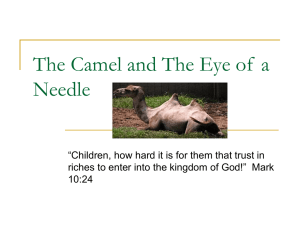
![KaraCamelprojectpowerpoint[1]](http://s2.studylib.net/store/data/005412772_1-3c0b5a5d2bb8cf50b8ecc63198ba77bd-300x300.png)
